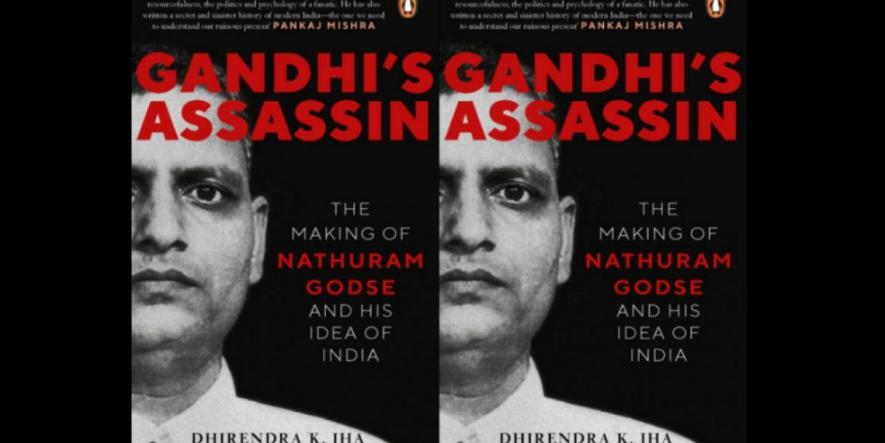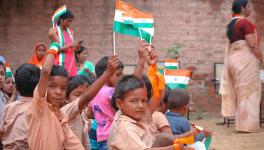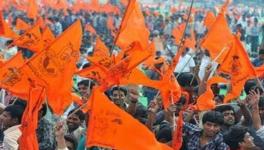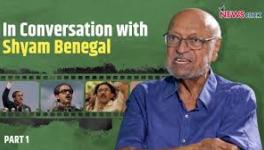Book review: ‘Gandhi’s Assassin: The Making of Nathuram Godse and His Idea of India’

Image credit: The Leaflet
MANY books and academic essays have been written over the years studying the assassination of Mahatma Gandhi on January 30, 1948. The role of Nathuram Godse, Gandhi’s assassin, and a protégé of Vinayak Savarkar – the chief theorizer of Hindutva, has also been examined closely by scholars. Even the conspiratorial role played by both the Rashtriya Swayamsewak Sangh [RSS] and the Hindu Mahasabha in the killing of Gandhi, and Godse’s association with both the organisations, at the same time, has been well documented in academic works. Considerable literature has also been produced on Gandhi’s murder trial in which, among others, Godse and Narayan Apte were awarded death sentence, and Savarkar, an accused, was exonerated for want of independent corroborative evidence.
Prominent works covering the above themes are author and activist Tushar Gandhi’s ‘Let’s Kill Gandhi !: A Chronicle of His Last Days, the Conspiracy, Murder, Investigation, and Trial’ (2007), lawyer A.G. Noorani’s ‘Savarkar and Hindutva: The Godse Connection’ (2002), English-American author Robert Payne’s ‘The Life and Death of Mahatma Gandhi’ (1969), lawyer P.L. Inamdar’s ‘The Story of the Red Fort Trial, 1948-49’ (1979) and American writer Larry Collins and French author Dominique Lapierre’s ‘Freedom at Midnight’ (1976).
Investigative journalist D.K. Jha’s latest book ‘Gandhi’s Assassin: The Making of Nathuram Godse and His Idea of India’ is the latest addition on the theme of Gandhi’s assassination and his assassin – Godse, and the politics that both inspired and informed him, leading him to kill Gandhi. Given that there is already a corpus of literature available on this theme, what is different or interesting about Jha’s book?
Gandhi’s assassination case revisited in light of new evidence
Jha’s book stands out from other books on this theme on few counts. First, it studies Gandhi’s assassination in light of new and hitherto untapped evidence, which has not been used by the researchers yet. Second, this book is perhaps one of the first complete biographical accounts of Nathuram Godse in English, attempting to look at and study the issue keeping the assassin at the centre. Third, Jha challenges the existing sources which claim that Godse was not associated with the RSS, by questioning its provenance and genuineness.
In a way, Jha’s new research, as incorporated in this amazing book, not only demolishes several of the narratives perpetuated by the RSS over the years with regards to Gandhi’s killing, but even set the record straight, yet again.
An identity marked by virile masculinity and power always tempted the young Godse, owing to his childhood experience, and later, an anxiety-driven adult life. This aspiration gets redeemed when Godse comes in contact with Savarkar. The taste of Hindutva politics, propounded by Savarkar, predicated mainly on chauvinism, bigotry, and anti-Muslim hatred, changed Godse’s life forever, as it gave both meaning and purpose to his life.
By focusing on the “assassin’s [Nathuram Godse] past … his complex childhood experiences, the pattern of his evolution, his relationship with different organisation and individuals around him … [and] the secret act committed in the name of Hindu Rashtra”, Jha argues that at the time of Gandhi’s assassination, “he [Godse] was working for both the organisations [RSS and Hindu Mahasabha] simultaneously” (p.278 ).
In support of this claim, Jha first cites the Marathi version of the 92 paged pre-trial statement of Godse given in the first week of March 1948, which hitherto has not been used by the researchers. This statement, however, was given eight months before he read out his much publicized statement in the court in November 1948 during his trial at Red Fort.
This Marathi version of his pre-trial statement, which Jha calls the highlight of his research, contradicts several claims Godse made during his trial in the court in November 1948 – in which, besides taking the entire responsibility of Gandhi’s assassination upon himself, Godse tries to protect his master- Savarkar, in which he eventually succeeds.
According to Jha, this pre-trial statement has remained untapped because “Godse’s pre-trial statement is almost entirely missing (from the National Archives of India [NAI]) – only the first page of the English translation of his statement, which was originally recorded in Marathi, is catalogued”. Jha further notes that, “[The Marathi] version is often difficult to read, not only because of the language barrier that it creates for a non-Marathi researcher but also because it was written by hand using a pencil and is at times so faded that it cannot be deciphered without the help of a magnifying glass”.
The other important source that Jha cites to substantiate his claim of Godse’s association with RSS during Gandhi’s assassination is a report prepared by intelligence agencies based on the papers confiscated from the RSS headquarters in Nagpur in the aftermath of Gandhi’s assassination.
In light of this new evidence, Jha argues that Godse never “depart[ed] from the RSS after he became a member of the Hindu Mahasabha”. (p. 278)
Jha’s book is neatly divided into two parts. Part one, entitled Ploy, deals with the early life of Godse, and the orthodox background in which he was raised. This is followed by the evolution of his political thought, and the role played by Savarkar, both as a political guru and an inspiration, in shaping his world view. Part two, entitled Plot, details the conspiracy hatched to kill Gandhi, followed by actors who played a direct role in it, and the ideology and organisations that acted as facilitator in this nefarious act.
Transition from Ramachandra to Nathuram – Gandhi’s assassin
Godse had a childhood different from ordinary children. Before he was born, barring a daughter, three sons of Vinayakrao and Lakshmi had died in quick succession during their infancy. This, his parents believed, was happening because of some divine curse. Therefore, when Godse was born, his parents thought to bring him up as female in order to trick the fate. This trick, however, worked, and Nathuram survived. Godse played with girls of his age while he was growing up, and dressed in female clothes.
Commenting on this phase of Godse’s life, Jha observes that, “The conflicted feelings that emerged from this effeminizing in his childhood seems to have affected Godse for the rest of his life”. (p.8) With the passage of time, and Godse stepping into his adult life, he showed a “longing to be accepted in his idea of a masculin[ity]…” of which he had remained almost bereft until then. As Jha notes, “In his later life, [Godse] showed a reluctance to discuss his childhood in public, referring to these memories only obliquely”. (p.9)
Later, both in education – as Godse failed in his matriculation exam – and thereafter, in a number of odd vocations in which he tried his hands, did not turn out to be a great success. This disappointment, however, was coupled with the pressure to support his family, as his father, who was in the postal services, was inching towards retirement, and Godse was the eldest son among his siblings.
In short, an identity marked by virile masculinity and power always tempted the young Godse, owing to his childhood experience, and later, an anxiety-driven adult life. This aspiration, however, later gets redeemed, when Godse comes in contact with Savarkar. The taste of Hindutva politics, propounded by Savarkar, predicated mainly on chauvinism, bigotry, and anti-Muslim hatred, changed Godse’s life forever, as it gave both meaning and purpose to his life which hitherto has remained nondescript.
Savarkar and his ideology of Hindutva
Savarkar has remained both a contested and polarizing figure in the history of India. This is due to the sharp contradiction one observes when one studies the trajectory of his political thought, and its egregious evolution subsequently.
Savarkar, during his initial years, was considered to be a revolutionary nationalist, as one comes to know from his initial writings, especially the tract he wrote titled ‘The Indian War of Independence’ published in 1909 while he was studying law in London, in which he talked glowing about Hindu-Muslim unity.
This Savarkar – with an anti-British attitude, however, stands in stark contrast, when we look at the Savarkar, who authored ‘Essentials of Hindutva’ in 1923, while he was lodged in Cellular Jail, serving his term of fifty years for his involvement in the murder of A. Jackson, the Collector of Nashik. In this book, Savarkar mainly talks about the looming threat from eternal enemies, mainly Muslims, and pitches to prioritize cultural nationalism over territorial nationalism.
In short, the seeds to establish the Hindu Rashtra, and the ideological underpinning on how to achieve it, was first conceptualised in concrete terms by Savarkar. The Hindutva that Savarkar has conceptualised, which is quite different from the pluralistic Hinduism, is inflexible, and in its imagination, Muslims were described as chief aggressors.
The politics of Hindutva post-1923 was just the application of the framework provided by Savarkar, endorsed by Hindu right organisations.
Importantly, the romanticism of this kind of exclusive form of nationalism by Savarkar, around which the politics of the 1920s and thereafter was defined, keeping religion at its core, had a backdrop. In a way, Savarkar’s transition, which has been referred to above, was a calculated response to the emerging social and political reality of the time in order to keep both him and his political vision relevant.
In the early twentieth century, the rising demand of political representation in legislative bodies, with the mass nationalism gathering steam, elicited some constitutional concessions from the colonial government. Prominent among them were the 1919 and 1935 Acts, which expanded the base of franchise, which hitherto had remained the sole preserve of the urban community. This socio-political churning, owing to which the urban commercial and professional class was becoming politically less relevant, however, was simultaneously taking place along with the non-Brahman movement in few of the provinces in British India.
This particular development can be best understood by looking at the tumultuous politics of Bombay province, which was the home province of Savarkar. On the Brahmin and non-Brahmin conflict, former diplomat T.C.A. Raghavan, in an essay, observes that, in Maharashtra, “The threat to the urban based Brahmin from the rich peasantry of Kunbi Maratha castes [who have also entered legislature], the attack upon Hindus in Punjab, and the Moplah rebellion in Malabar all seemed to have a common cause – weakness and disunity among Hindus.”
To contain this caste conflict, Raghavan notes, “Savarkar tried to give a cultural definition to the word Hindu to stress the common racial history of all Hindu.” For his project, Savarkar conceptualised two tools – Hindutva and Sangathhan. The former, as Raghavan notes, would unify the Brahmin and non-Brahmin as being of the same cultural background, and also attempted to increase the unity of Hindus against Muslims. While, though later, “removing the caste differences and prejudices would complete the task that Hindutva began.”
After experimenting with this model of politics in the laboratory of Bombay province, Savarkar thought of trying it at the pan-India level. After his internment ended in 1937, and upon becoming the President of the Hindu Mahasabha, Savarkar started canvassing the philosophy of Hindutva, that too with a missionary zeal.
To the chagrin of Savarkar, the Indian National Congress, the principal vehicle of the nationalist movement, with leaders like Gandhi and J.L. Nehru at its forefront, didn’t just dismiss the idea of Hindutva, but even explained to the masses how diabolical this idea was is in their fight against the colonial power. By virtue of the Congress being a pan-India party, representing all castes and communities, secularism and democracy formed its backbone. Therefore, there was no place for sectarianism in Gandhi’s scheme of things.
This development, however, didn’t just frustrate Savarkar to the core, but as Jha observes, thereafter “much of Savarkar’s life would be defined by his antipathy towards Gandhi”. (p.34)
Consequently, Savarkar started bashing everything for which Gandhi stood, prominent among them being, Hindu-Muslim unity and non-violence. According to Savarkar, by resorting to these tools, Gandhi was fooling and making Hindus weak. Gandhi even came be identified by the Savarkarities as a Muslim sympathiser. With the passage of time, Savarkar’s antipathy got metamorphosed into hatred against Gandhi, as his model of politics was fast losing its relevance.
The Savarkar-Gandhi conflict is best summed by Jha in the following words, “For a section of Chitpawan Brahmins [both Savarkar and Godse came from this caste], particularly those who couldn’t reconcile with the gap between their traditionally privileged position and their actual status in the contemporary socio-political setting, anxiety was a permanent emotion of the time. As they longed to redeem their lost glory, the charisma of Gandhi didn’t appeal to them.” (p. 32)
Before one forgets, it also needs to be recalled that the idea of Hindus and Muslims constituting two nations was first given by Savarkar. Later, the All-India Muslim League, with M.A. Jinnah at the driving seat, exploited this divisive idea to its hilt by playing with the anxieties of the Muslim elite. So, both Hindu and Muslims communalist political parties were feeding each other. Needless to mention, this regressive politics was collectively frustrating the cause of the national movement.
When Godse meets Savarkar, and thereafter …
Godse met Savarkar for the first time when he was nineteen years old in 1929 at Ratnagiri, where the latter was serving his internment post his release from Cellular Jail. As mentioned earlier, Godse’s father was in the postal service, so he was frequently transferred, and the last transfer brought him to the coastal town of Ratnagiri in Bombay province. By late 1920, Savarkar has established himself as a proponent of Hindutva, and at least in Bombay province, and especially among Chitpawan Brahmins, he had gained unparalleled popularity.
Therefore, so mesmerized was Godse with Savarkar, and his domineering personality, about whose revolutionary activities he had heard while growing up, that in no time the latter became his alter ego.
Later, Godse became close to Savarkar, particularly after 1938, when he joined the Hindu Mahasabha, with Savarkar at its President. It is to be noted here that Godse joined the Hindu Mahasabha without severing his bond with the RSS. For political purposes, Godse even used to travel frequently with Savarkar to distant places.
Savarkar and Godse didn’t just share the strict relationship that usually is witnessed between any normal member of an organisation and its President. It was much more than that. Savarkar gave a loan to Godse for opening a newspaper named Agrani, of which Godse was the editor. This paper mainly published outrageous articles fomenting hatred against Muslims, or criticising Gandhi’s policies. Many a times, because of such articles, the newspaper was censured, and even fined.
The radicalisation of Godse didn’t happen overnight. Rather, it was gradual but pervasive. Such was the effect of Savarkar, and his politics marked by anti-Muslim hatred, that Godse got influenced by both, and subsequently, internalised it. The communally charged environment, in small pockets of Bombay province, in which Godse was undergoing political development, was also responsible for his radicalisation.
Thus, the assassination of Gandhi by Godse was but the manifestation of this year-long radicalisation.
Challenging the myth
In an attempt to exonerate itself from the charges of Gandhi’s murder, the RSS, besides the propoganda, as Jha points, has clung on to two sources that it has passed off as authentic piece of evidence.
First is an article published in the February 4, 1950 issue of the Economic Weekly, written by D.V. Kelkar, a close associate of K.B. Hedgewar, the founding sarsanghchalak (chief) of RSS. In this article, highlighting the discord and rift between the two organisations – the Hindu Mahasabha and the RSS, Kelkar quotes Savarkar saying that, “The epitaph for the RSS volunteer will be that he was born, he joined the RSS and died without accomplishing anything”. However, as Jha questions, Kelkar neither “cites any reference to back his claims” nor shed any light on its “provenance”. Moreover, given the closeness of Kelkar with the RSS, Jha wonders, “this fact leaves enough room for suspicion that the author, out of symapathy for the RSS, might deliberately have twisted historical facts to help the Sangh”. (p. 277). It needs to be remembered that this window dressing is taking place subsequent to Gandhi’s assassination, when the Indian state is cracking down on the RSS because of its involvement in it, based on intelligence reports.
Another source that Jha challenges is the American author J.A. Curran, Jr.’s ‘Militant Hinduism in Indian Politics: A Study of the RSS’ (1951). In this study, Curran states that “Godse has joined the R.S.S. in 1930, winning prominence as a speaker and organizer, he left the Sangh in 1934 because Hedgewar refused to make the R.S.S., a political organisation”. Jha questions the authenticity of this text by observing that Curran “cites no source – neither a document nor an interview – for this information”. Moreover, Jha notes that Curran’s above observation “completely contradicts the chronology in Godse’s own statement and all historical records.” (p. 70)
Jha, in light of the above, concludes that “[b]efore the assassination of Gandhi, the RSS and the Mahasabha showed a notable tendency towards close cooperation and often developed fluid and overlapping membership. There was nothing unique in what Godse was attempting – the two organizations were intertwined and reciprocally stimulated each other.” (p.63)
Assassination
Gandhi’s assassination, at the hands of Godse, was an outcome of an amalgamation of deep seated hatred and conspiracy.
The plan to kill Gandhi, on both the occasions, by Godse and gang, was made in Bombay. The first plan to kill Gandhi was attempted on January 20, 1948, which got foiled because of the lack of coordination among the member of the group, which was led by Godse and Apte. In this, Madanlal Pahwa, a Punjabi refugee, was arrested from the spot. During interrogation, Pahwa had given enough evidence, and even said that the gang would again plan an attack on Gandhi. On the basis of this statement, Godse and gang could have been arrested, but the police and the intelligence agencies failed miserably. Till today, it remains a mystery why, despite having advance inputs, the authorities were unsuccessful in foiling the subsequent assassination attempt.
In this next attempt, on January 30, 1948, Godse killed Gandhi, shooting him at point blank range. Gandhi – the apostle of non-violence, succumbed to his injuries.
It needs to be remembered that on both the occasions, before heading to Delhi, Godse and Apte had met Savarkar at his house – Savarkar Sadan, in Bombay.
Murder trial
In Gandhi’s murder case, the charge sheet was filed against nine people. Savarkar, along with Gopal Godse, Nathuram’s brother, was included in it. The charges against them, inter alia, was of conspiracy to kill Gandhi.
Therefore, conspiracy formed an integral part of Gandhi’s murder trial.
Given that all the evidence was against Godse, and therefore it was next to impossible for him to defend himself, he made peace with it, and didn’t want to pursue a lost cause. So was the case with Apte, against whom the police had much direct evidence.
However, by taking the entire responsibility of the killing on himself, Godse thought, or he was made to think, that he could save others, especially his mentor Savarkar, for whom he had high regard.
Thus, Godse did accordingly, as is evidenced from the statement he read in the court, both justifying Gandhi’s killing and saving his mentor, which ran into 150 paragraphs. There was manifest strangeness in Godse’s statement. First, as Jha notes, “Godse’s statement in the court showed his impeccable command over English, a language he supposedly didn’t know well. Those who have known him since pre-assassination days were genuinely surprised by his competence.” Second, Godse repeated from Savarkar’s ‘Essentials of Hindutva’ while criticizing belief in ahimsa.
In a way, Godse’s trial statement, which he read quite boldly in court, appears to be an act of parroting the brief that has been given to him on behalf of someone. Indeed, what was unfolding at the Red Fort was Gandhi’s murder trial, but Godse’s act suggests that he just had one mission – to save his master.
Though Godse cited post-partition violence, in which hundreds of thousands of Hindus were killed by Muslim fanatics, as one of the reasons for killing Gandhi, this reasoning is far from the truth. This is because the partition was not a one man show. Rather, it was a complex process, and there were many actors in it. So was the case with violence that ensued post-partition. Therefore, holding Gandhi responsible for any of the above is nonsense, and branding him as a Muslims sympathiser is just childish.
Yes, Gandhi was the biggest hurdle in the path of those who were not able to deepen the root of sectarian politics, and his presence pricked the proponents of Hindutva.
However, Digambar Badge, who had supplied arms and ammunition, and had even accompanied Godse and gang to Delhi on January 20, 1948 to kill Gandhi, turned approver in this case. Despite this, Godse said that Savarkar has nothing to do with the murder of Gandhi.
Badge’s testimony was important because the entire case of conspiracy was standing on it. Badge, among other things, was witness to the meeting between Godse and Apte with Savarkar on two occasions before the 20 January attack on Gandhi.
Savarkar pleaded not guility. In his defence, Savarkar argued in an impassioned way, and tried to refute all the allegations level by the prosecution and demolish the testimony of Badge. Strangely, despite acknowledging that Badge’s testimony was true, the court found that, in want of independent corroborative evidence, it didn’t hold much weight.
Eventually, for want of evidence Savarkar was exonerated. Godse and Apte were awarded death sentences. While two others who were chargesheeted remained absconding, and were never tried. The rest were awarded life imprisonment. Later, on appeal, two among these were exonerated.
The murder trial didn’t give closure to this case. People always had misgivings about it given the histrionics of both Godse and Savarkar during the course of trial, and the statements which both read in the court
In 1965, a commission headed by Supreme Court judge Justice Jeevan Lal Kapoor was formed to look into the aspect of conspiracy in Gandhiji’s killing.
In 1969, the Commission, while indicting Savarkar observed that, “All these facts taken together were destructive of any theory other than the conspiracy to murder by Savarkar and his group.” Interestingly, the missing gap (or the crucial evidence), because of which Badge’s testimony was not accepted in 1948-49 and Savarkar was exonerated, was completed by two aides of Savarkar. In their testimony, the two aides of Savarkar, told the Commission that on both January 14 and 17, Godse and Apte had met Savarkar. Had these two aides deposed during the trial in 1948, Savarkar would not have been saved from gallows.
All this, however, happened after Savarkar died in 1966. Justice was therefore served in Gandhi’s assassination case, but it was inordinately delayed.
Concluding thoughts
Jha’s book is eminently readable, and even has contemporary relevance. For, Jha in his well-researched book, besides exposing the sanitization programme of Hindutva forces by distancing itself from the killer of Gandhi, provides us a conduit to look into the contested politics of pre-independence era, and how religion played a divisive role in it. Presently, however, the unfolding of politics in India is no different from what one witnessed then – marked by hatred and bigotry. If history provides any lesson, then the political culture, as being witnessed in India lately, marked by jingoism and cultural nationalism, must give way to a constitutional culture based on fraternity and brotherhood. Those who are glorifying and eulogizing Godse by branding him as patriot should read Jha’s book, and ponder, whether the one who shot Gandhi – the father of the nation, was actually a nationalist or a murderer.
However, had Jha included a chapter dealing with how the Godse cult has influenced politics since 1950 in his book, and more importantly, how the ideology by which Godse stood by is shaping contemporary politics, the book would have provided a more holistic picture of the phenomenon called as Godse. One hopes that Jha, in the next edition of this book, incorporates this aspect.
(Md. Zeeshan Ahmad is a Delhi-based lawyer. The views expressed are personal.)
Get the latest reports & analysis with people's perspective on Protests, movements & deep analytical videos, discussions of the current affairs in your Telegram app. Subscribe to NewsClick's Telegram channel & get Real-Time updates on stories, as they get published on our website.
























